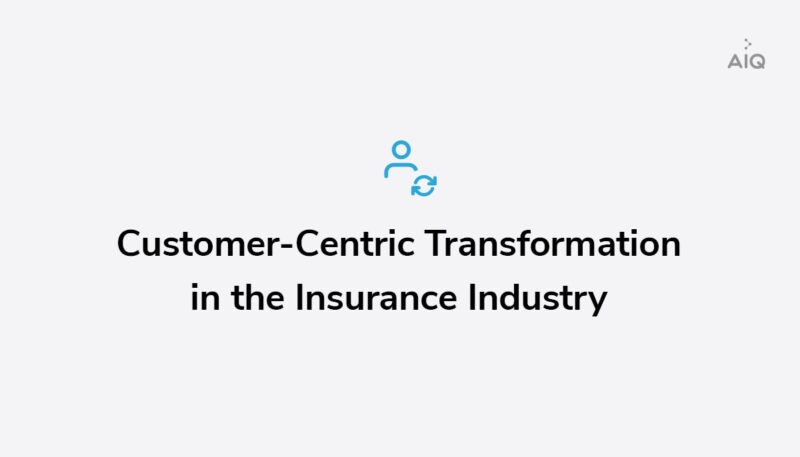Customer-Centric Transformation in the Insurance Industry

Today’s consumer wants to interact with their insurer across multiple touchpoints—online and offline. The EY 2020 Global Insurance Outlook cites “rising customer expectations,” specifically around digital channels and personalized experiences, as one of the three fundamental forces shaping the insurance market around the globe.
The hyper-competitiveness of the insurance industry is apparent. The big players spend billions on mass media and digital advertising campaigns to go after the high churn segments consumer segments of the market. New entrants like Bolt and Insureon are betting on a digital-only approach to winning new business, while Lemonade is quickly becoming known as the “Amazon for insurance.”
It’s easy enough to get a feel for the competitiveness in this market yourself: simply go online and request an instant price quote for auto or home insurance—and within 24 hours you’re certain to be bombarded with calls and emails from firms looking to win your business.
Supporting the Customer Throughout Their Journey
But while some insurance products are commoditized—making price and slick messaging the main competitive battleground for winning business—purchasing decisions in other segments of the industry are more heavily researched and considered. And the products can be far more complex.
Yet the high expectations for digitally-enabled personalized experiences remain.
“Competitive advantage in the space goes to the organizations who can process data the fastest, and be most relevant in the moment,” says Aaron Tellier of Merkle, an EVP who oversees the firm’s insurance and wealth management practice.
In a more sophisticated purchase, the criteria for relevance changes based on where the customer is along their journey.
Understanding the Customer Across All Touchpoints
According to Accenture, an integrated multi-channel capability is essential for insurers who want to provide these types of rich customer experiences and scalable service, while achieving greater operational efficiency. And it all hinges on the comprehensive collection, analysis and activation of data. But established insurers can have hundreds of databases that house operational data, and these contain—at best—only a partial picture of the customer.
At the crux of the challenge: many insurers have historically operated through a single channel—local brokers and agents who resell the insurer’s policies. And they rely on third-party administrators to manage and process claims.
“Agents would sell our policies, and then they would kind of come over the fence to us,” says Watts. In this mode of operating, the insurer possesses very little of the customer behavioral data that is required to deploy personalized, customer-centric experiences. And without ownership of the touchpoints, firms have little control over those experiences.
Transforming the Customer Experience
For established insurers, meeting and exceeding the expectations of today’s policy shopper and policyholder amounts to nothing short of a total transformation. Implementing new direct-to-consumer channels, harnessing the detailed insights in the customer behavioral data they capture and bringing in-house the processes and touchpoints that control the customer experience.
And the new capability can’t be added in a vacuum. Rather, it needs to be done in a centralized manner to avoid what Tellier describes as the “forgetful friend syndrome” where “we implement a great experience in onc channel, then you move to another channel and they’re like ‘who are you?’”
How does an insurer create seamless, multi-channel customer experiences that span old channels and new, without completely disrupting existing systems and processes? It’s akin to repaving a highway while cars are still driving on it.
Smart Hub CDPs at the Foundation of CX
To solve the challenge, established insurers are turning to customer data platform (CDP) solutions that are designed to serve as “smart hubs.” So, what is a CDP smart hub? CDP smart hubs are designed to 1) collect all granular customer data generated across touchpoints new and old 2) unify it to a single ID 3) make it available for self-service analysis by business users and 4) orchestrate analytics-driven experiences across every customer touchpoint, whether offline or online.
Because the CDP is designed to work alongside existing technology, disruption is limited. Insurers can focus exclusively on the forward progress of their transformation strategy with maximum speed to market and maximum benefit. Enterprise-class CDPs also meet the strict privacy and security standards required of insurers—maintaining SOC 2 Type 2 compliance and supporting standards such as GDPR, CCPA, HIPAA and others. Freeing up the entire organization, from IT to business, to focus on the customer.
Transforming the Organization
Smart hub technology is the enabler. But transforming the organization overall is as critical—or perhaps more critical—than the technology alone. “Your competitive advantage doesn’t lie in your technology,” says Tellier. “It’s the people and processes you use to leverage that tech.”
Having a change management strategy is key for any organization looking to undergo a data-driven transformation. With technology and processes that never existed before—or were previously done by partners—now coming in-house, any organization is certain to be faced with a skills gap. And with the customer now at the center of everything, the org structure itself is likely inappropriate for achieving its customer-centricity goals.
Most successful change management efforts centered around a smart hub CDP will be comprised of these key elements:
Executive sponsorship. Start out by identifying the customer experience use cases most important to your organization, and work to get executive-level alignment and commitment around them.
Cross-functional alignment. Identify all stakeholders across all relevant functions, capture their input, and bring them along with you for every step of the journey. This of course includes your field agents and brokers as well as those responsible for new channels.
Governance and accountability. Create a task force that will drive your organization’s transformation over the long term, ensuring ownership, accountability and structured reporting back to all stakeholders.
Most of all, “be patient,” says Watts. “Transformation doesn’t happen overnight.”
Additional Resources
To learn how to get your CDP-centric transformation started off with a strong foundation, read the eBook CDP Change Management Best Practices.





